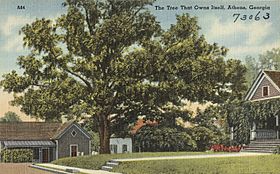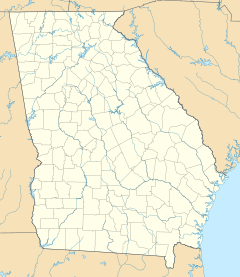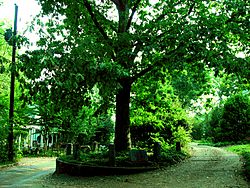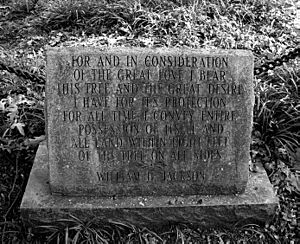Tree That Owns Itself facts for kids
Quick facts for kids The Tree That Owns Itself |
|
|---|---|

Postcard of the tree from the 1930s or 1940s
|
|
| Species | White oak (Quercus alba) |
| Coordinates | 33°57′17″N 83°22′56″W / 33.954779°N 83.382325°W |
| Date seeded | mid 1500s - late 1700s (replaced in 1942) |
| Date felled | 1942 (replaced) |
| Custodian | Itself |
The Tree That Owns Itself is a famous white oak tree. People say it legally owns itself and the land around it. This land is about 8 feet (2.4 meters) in every direction from its base. The tree is also known as the Jackson Oak. You can find it in Athens, Georgia, in the United States.
The first tree probably started growing between the mid-1500s and the late 1700s. It fell down in 1942. But a new tree, grown from one of its acorns, was planted in the exact same spot. This new tree is sometimes called the Son of the Tree That Owns Itself. Both trees have been in many national newspapers and magazines. The spot is a well-known local landmark. Even though the story is popular, neither tree actually has legal rights.
Contents
The Tree's Famous Story
The oldest known story about the tree appeared in the Athens Weekly Banner newspaper. This was on August 12, 1890. The article was titled "Deeded to Itself." It said the tree was on land owned by Colonel William Henry Jackson.
William Jackson was the son of James Jackson. His father was a soldier in the American Revolution and a congressman. He was also a U.S. senator and a governor of Georgia. William Jackson's own son, also named James Jackson, became a congressman and a judge.
The story says that William Jackson loved the tree from his childhood. He wanted to protect it forever. So, he supposedly wrote a special paper called a deed. This deed gave the tree ownership of itself and the land around it. People say this happened between 1820 and 1832.
The newspaper article said the deed read:
I, W. H. Jackson, of the county of Clarke, of the one part, and the oak tree ... of the county of Clarke, of the other part: Witnesseth, That the said W. H. Jackson for and in consideration of the great affection which he bears said tree, and his great desire to see it protected has conveyed, and by these presents do convey unto the said oak tree entire possession of itself and of all land within eight feet [2.4 m] of it on all sides.
It's not clear if this story started with the newspaper article. It might have been a local folklore story before that. The writer of the article said that in 1890, only a few people still remembered the story.
The story of the Tree That Owns Itself is very famous. Most people tell it as if it's completely true. However, only one person has ever claimed to see Jackson's deed. That was the anonymous writer of the "Deeded to Itself" article. Most writers agree that the deed is lost, or maybe it never even existed.
Even if such a deed did exist, it would not be legal. Under common law (traditional law), the person receiving property must be able to legally own it. A tree cannot legally own property.
William H. Jackson did own land across the street from the tree. But the tree itself was on a different piece of land. Jackson and his wife sold their land in 1832. This is the same year mentioned on a plaque as the date of the tree's deed. Records in Clarke County don't show when Jackson bought his land. It's also said that Jackson spent his childhood in Jefferson County, Georgia, not Athens. This makes it less likely he played under the tree as a child.
Newer property records suggest the tree's area is part of the property at 125 Dearing Street. But the actual map for that property does not include the tree's corner. The tree's area is not part of that property for tax reasons.
This doesn't mean the tree owns itself. It means the tree is likely in the right-of-way along Finley Street. This is public land. The government of Athens-Clarke County says the tree is in this public area. This means the city helps care for it. City officials and the owners of the nearby property act as "stewards" for the tree. The Athens Junior Ladies' Garden Club is its main supporter.
Even if the deed isn't legal, people have always respected the tree's story. The Athens-Clarke County government officially says that the tree, despite the law, does own itself. The city of Athens also has a rule to take care of it as a public street tree.
The Original Tree's Life Story
The first Tree That Owns Itself is thought to have started growing between the mid-1500s and the late 1700s. Some people believed it was the biggest and most famous tree in Athens. The tree was there long before houses were built in the area in the mid-1800s.
By 1906, the soil around the tree was wearing away. A man named George Foster Peabody paid to add new soil. He also had a special tablet and a chain fence put around the tree. This fence was held up by eight granite posts. Even with these efforts, the tree was badly damaged in an ice storm in 1907. Although people tried to save it, the tree was already rotting inside and became weak.
The original oak tree fell on the evening of October 9, 1942. It had been slowly dying for a long time. People knew it was in poor condition. Soon after it fell, there was a plan to replace it with a "son" grown from one of its own acorns. Some say the tree had actually died a few years before it fell because of root rot. The tree was over 100 feet (30 meters) tall. It was estimated to be between 150 and 400 years old when it fell.
The Son of The Tree That Owns Itself
After the first tree fell, its small plot of land was empty for four years. Dan Magill, a young boy, suggested that his mother's club, the Athens Junior Ladies Garden Club, find a new tree. Several people in Athens had grown seedlings from the original tree's acorns. A 5-foot (1.5-meter) tall seedling growing in Capt. Jack Watson's yard was chosen. Roy Bowden from the University of Georgia's College of Agriculture helped plant it.
The new tree was officially dedicated in a ceremony on December 4, 1946. Athens Mayor Robert L. McWhorter led the event. The pastor of the First Presbyterian Church gave a short prayer. Capt. and Mrs. Watson and members of the Garden Club were also there. The Club President, Patsy Dudley, said her group would take care of the tree's plot. The new tree, trimmed to just 3 feet (0.9 meters) for planting, grew well in its new spot.
This tree is widely seen as the true heir of the original tree, even if not legally. It is sometimes called the Son of The Tree That Owns Itself. But most people just call it "The Tree That Owns Itself," like its parent. By 2006, the tree was over 50 feet (15 meters) tall.
On December 4, 1996, the Garden Club celebrated the 50th anniversary of the new tree's planting. Dan Magill, who had first suggested planting a new tree, was the host.
The tree is on a small hill at the corner of Dearing and Finley Streets. This is a quiet neighborhood near downtown Athens and UGA. The part of Finley Street leading to the tree is Athens' only remaining cobblestone street. The tree's small area looks separate from the nearby property. This is because of a private driveway and a retaining wall with a chain fence around it. Even though it's in a neighborhood, the Tree That Owns Itself is open to everyone. Many visitors come to see it.
The story of the Tree That Owns Itself is more of a legend than a true historical fact. But the tree has become a very famous symbol of Athens. It's as well-known as the University Arch and the Double-Barreled Cannon. You can often find it in travel guides. It has even been featured in Ripley's Believe It or Not! several times, gaining international fame.
Special Plaques and Markers
There are two stone plaques at the tree's site. One is old and worn out. The other looks much newer. Both plaques share a similar message. They take words from William H. Jackson's supposed deed to the tree. They change the legal words into a personal message of love:
For and in consideration of the great love I bear this tree and the great desire I have for its protection for all time, I convey entire possession of itself and all land within eight feet of the tree on all sides
William H. Jackson
A small brass plaque, about the size of a playing card, is on the older stone tablet. It says:
A
Descendant of the
Tree
That Owns Itself
Planted by the
Junior
Ladies Garden Club
1946
There is also a larger brass plaque on the concrete wall around the tree. This plaque says:
The Tree That Owns Itself
Quercus alba
Deeded to itself by Col. William H. Jackson
circa 1832
This scion of the original tree was planted by
the Junior Ladies Garden Club in 1946
National Register of Historic Places 1975
Athens Historical Landmark 1988
The entire Dearing Street Historic District, where the tree is located, was added to the National Register in 1975. This area was recognized for its special buildings. The tree itself was named a local historic landmark on February 2, 1988.
Other Trees with Similar Stories
There is another tree with a very similar story. It's just across the border in Eufaula, Alabama. This oak tree was also supposedly given legal ownership of itself on April 9, 1936. Its plaque says, "Only God can make a tree." Like the Athens tree, it fell in a storm on April 9, 1961. A new tree was planted in its place just ten days later, on April 19, 1961.
See also
 In Spanish: El árbol que se pertenece a sí mismo para niños
In Spanish: El árbol que se pertenece a sí mismo para niños






